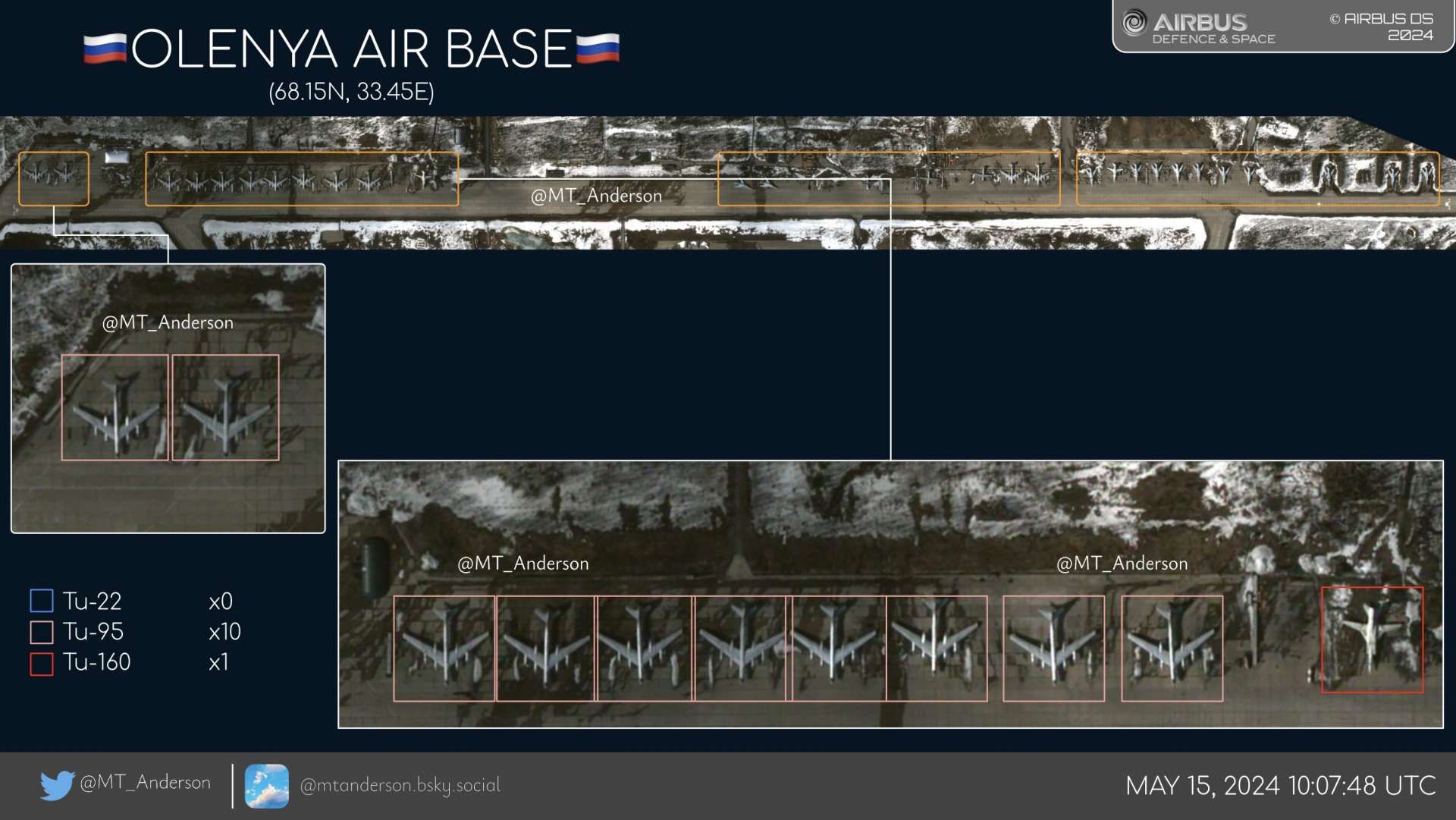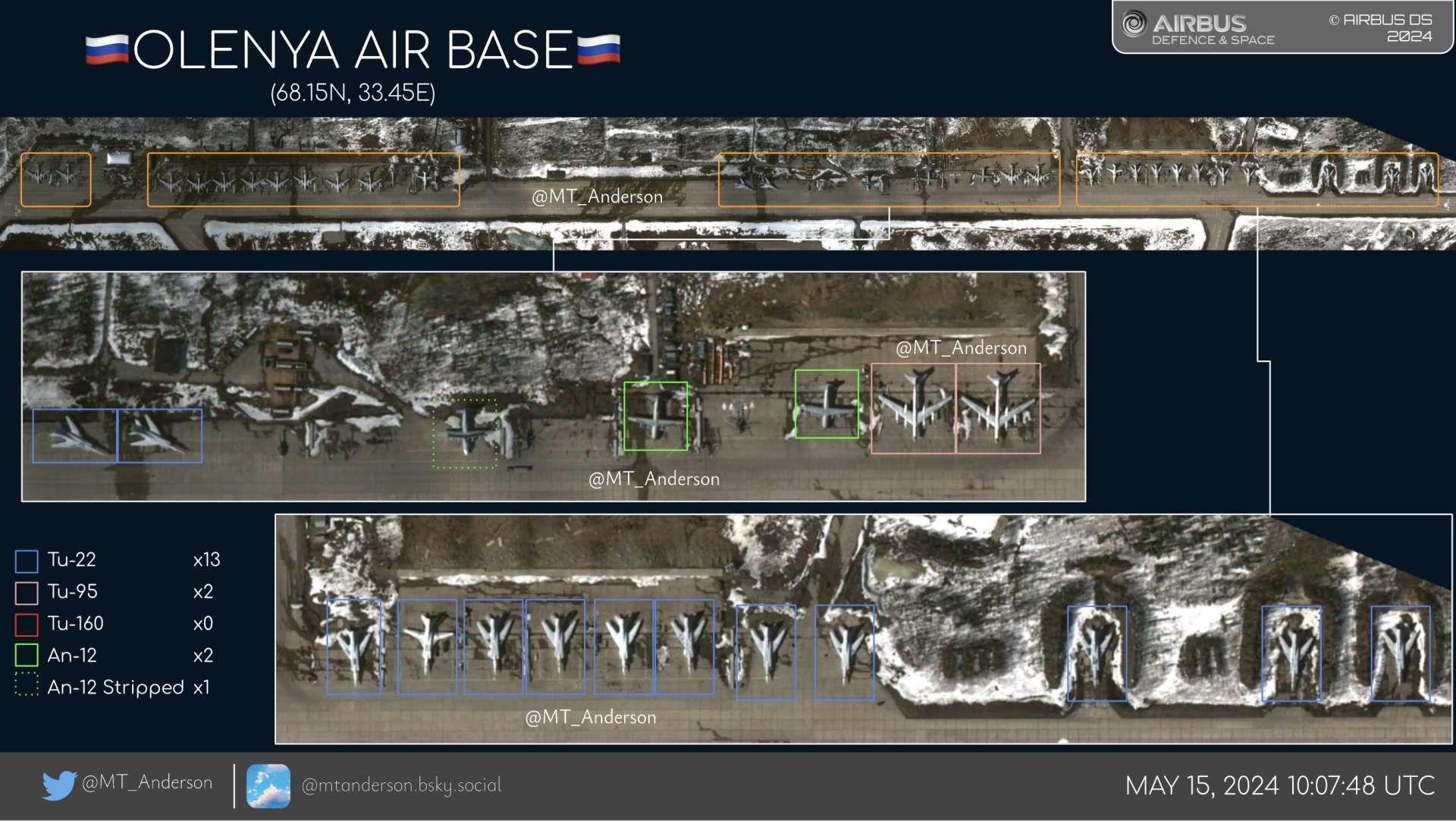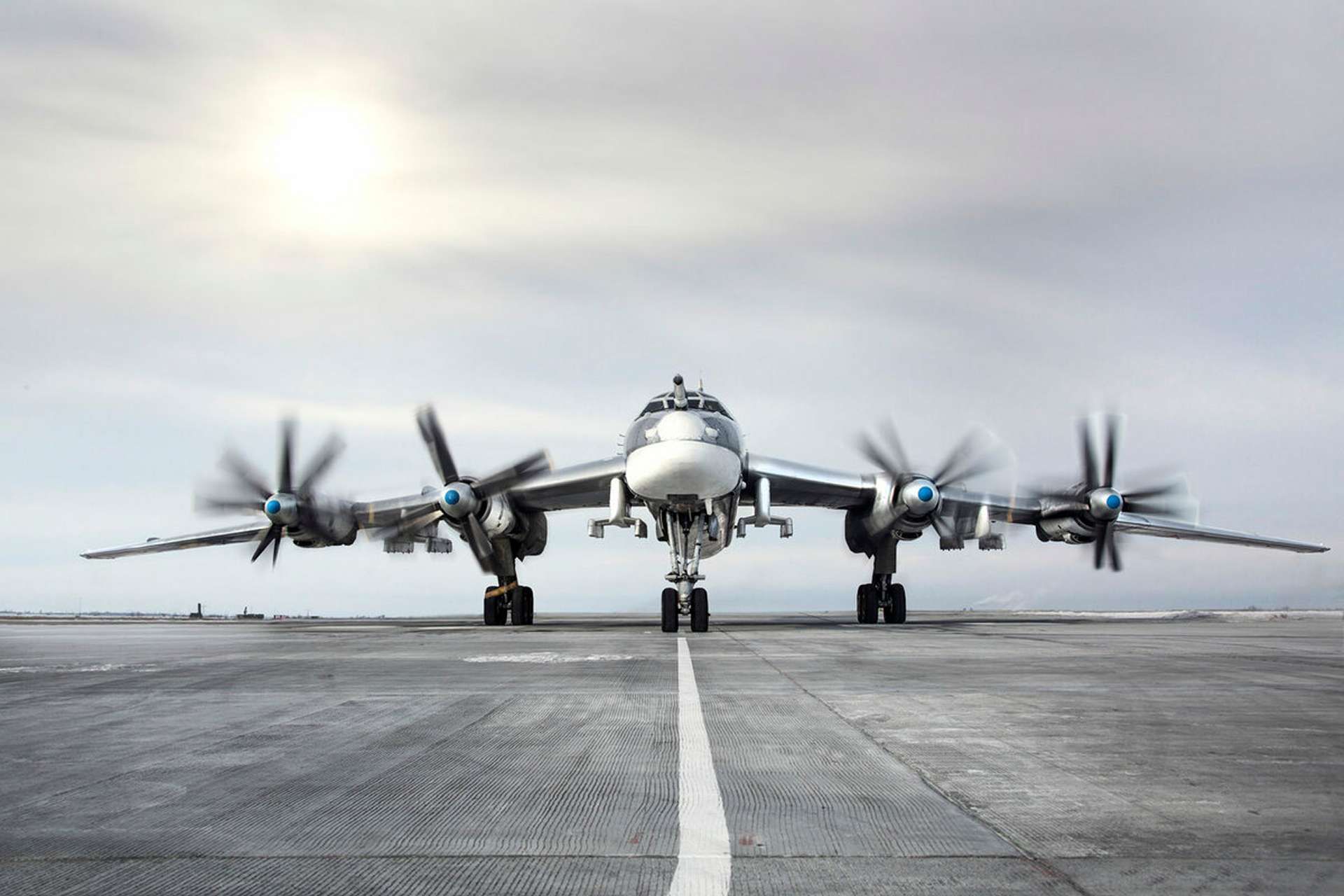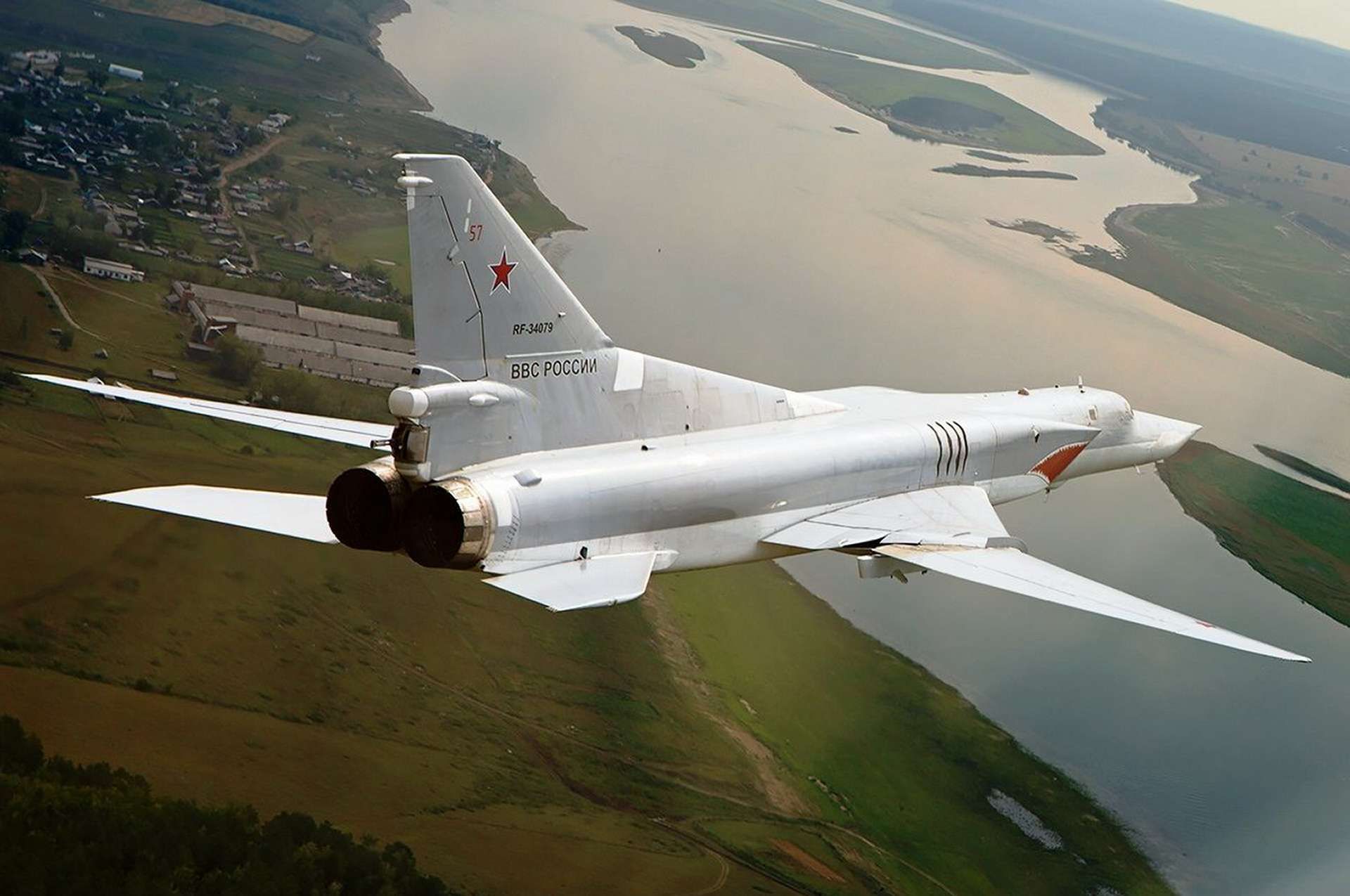Breaking news
Analysis: Why has Russia concentrated one-third of its strategic bombers at Olenya Air Base?.
On May 17, 2024, OSINT researcher MT Anderson reported significant movements in the Russian Aerospace Forces' strategic aircraft deployment, as highlighted by recent satellite imagery. Specifically, on May 15, 2024, the satellite images recorded the presence of 12 Tu-95MS, 13 Tu-22M3, a Tu-160 strategic bomber (later identified as another Tu-22M), and two An-12 military transport aircraft at Olenya airfield in the Murmansk region.
Follow Army Recognition on Google News at this link

To date, intelligence assessments from the British and Ukrainian defense ministries have estimated that the total combat-capable fleet of Tu-95MS and Tu-22M3 bombers within the Russian Aerospace Forces numbers approximately 40 aircraft. And for the Tu-160 bomber, shown here, the estimated number of aircraft is approximately 30. (Picture source: Russian social media)
Located 1,800 kilometers north of the Ukrainian border, Olenya Air Base, situated on the Kola Peninsula in Murmansk Oblast, Russia, has become a significant location for the Russian strategic bomber fleet. The base hosts long-range bombers such as the Tu-95MS and Tu-160, which can carry both conventional and nuclear cruise missiles. This relocation to Olenya occurred after the Engels Air Base in the Saratov region was targeted by Ukrainian drones in 2023, leading the Russian Air Force to transfer more than ten bombers to Olenya in an effort to position such aircraft beyond the reach of Ukrainian drones.
Olenya, also known as Olenegorsk, has historically functioned as a Russian Navy reconnaissance base, located 92 km south of Murmansk. As of 2020, units at the base report to the Long-Range Aviation branch of the Russian Aerospace Forces. The base and its accompanying staff settlement, Vysoky, Murmansk Oblast, are served by the Olenegorsk rail station. Olenya has been the headquarters for the 5th Naval Reconnaissance Air Division and has hosted two reconnaissance regiments. Its 3500-meter runway, the longest on the Kola Peninsula, is a key facility for intercontinental flights across the North Atlantic basin.
The base houses the 40th Composite Aviation Regiment, which is part of the 22nd Guards Heavy Bomber Aviation Division. Olenya Air Base has been associated with significant events, such as the departure of the Tu-95V aircraft carrying the Tsar Bomba, the most powerful nuclear weapon ever detonated, on October 30th, 1961. Additionally, according to Russian media, the first test launch of the Kh-47M2 Kinzhal, a nuclear-capable air-launched ballistic missile, occurred in mid-November 2019 from Olenya. The launch, carried out by a MiG-31K, demonstrated the missile's ability to reach speeds of Mach 10 and hit a ground target at the Pemboy proving ground.
The Russian Olenya Air Base was first identified by US intelligence in 1957 and served as a forward deployment field for Long Range Aviation and was one of nine Arctic staging facilities for nuclear strikes on the United States. During the Cold War, the base was a refueling stop for the Moscow to Havana route of the Tupolev Tu-114. Currently, Olenya is involved in Russia's military operations against Ukraine, with bombers from this base launching numerous cruise missile attacks. The proximity to Finland and Norway, both NATO members, further highlights the base's strategic importance, as it frequently participates in sorties that cross into European airspace, occasionally leading to incidents such as incursions into Polish airspace.
Located 1,800 kilometers north of the Ukrainian border, Olenya Air Base, situated on the Kola Peninsula in Murmansk Oblast, Russia, seems to become a significant location for the Russian strategic bomber fleet.
Open-source intelligence (OSINT) estimates of Russia's fleet of Tu-22, Tu-22M, Tu-95, Tu-160, and An-12 aircraft show some variation. As of 2024, OSINT data indicates the Russian Air Force has 58 Tu-22M, 47 Tu-95, 15 Tu-160, and 55 An-12 aircraft. Another assessment from 2023 details the Long-Range Aviation Command's equipment, listing 16 Tu-160 Blackjacks, and 60 Tu-95MS Bears, all able to carry Kh-55SM or Kh-102 cruise missiles. Additional data from 2023 reports the Russian Air Force's total combat-capable aircraft as 1,153, including 60 Tu-22M3, 1 Tu-22MR, 33 Tu-95MS, 27 Tu-95MS mod, 7 Tu-160, 7 Tu-160M, and 2 Tu-160M Blackjacks in testing, along with 65 An-12BK transport aircraft.
To date, intelligence assessments from the British and Ukrainian defense ministries have estimated that the total combat-capable fleet of Tu-95MS and Tu-22M3 bombers within the Russian Aerospace Forces numbers approximately 40 aircraft. The remainder of these bombers are non-operational due to Ukrainian drone strikes, sabotage operations, or other non-combat-related factors. The current assembly of one-third of these combat-ready bombers at Russia's Olenya Air Base suggests preparations for potential new strikes on Ukrainian infrastructure while also indicating measures to protect these aircraft from possible drone attacks.
Additionally, the presence of An-12 transport aircraft at Olenya suggests their use in logistical operations to transport cruise missiles, supporting the base's role in ongoing military activities. This logistical support is crucial for maintaining operational readiness for further missile strikes. Ukrainian military analyst Oleksandr Kovalenko has suggested that this move is part of Russia's preparations for a large-scale strike on Ukraine. Kovalenko indicated that Russia's strategy involves targeting Ukraine's energy infrastructure through missile attacks, with an estimated 30 to 40 missiles potentially being used.
He mentioned that these strikes could occur within the next one and a half to two and a half weeks, utilizing the Tu-95MS and Tu-22M3 bombers. Additionally, Kovalenko detailed that the Tu-95MS bombers are likely to use X-101 and X-55 missiles, while the Tu-22M3 bombers might deploy X-22 or X-32 missiles. He noted that Russia can produce up to two missiles per day of these types, allowing for a continuous replenishment of their stockpile.


On May 15, 2024, the satellite images recorded the presence of 12 Tu-95MS, 13 Tu-22M3, a Tu-160 strategic bomber (later identified as another Tu-22M), and two An-12 military transport aircraft at Olenya airfield in the Murmansk region. (Picture source: Twitter/MT Anderson)
According to Ukrainian aviation expert and leading researcher at the National Aviation University (NAU), Valery Romanenko, this Russian decision is a precautionary measure to safeguard these bombers from potential Ukrainian attacks. Romanenko stated that the Russians are moving their bombers preemptively to avoid attacks, anticipating the possibility of Ukraine receiving permission to strike Russian territory with American weapons. The Engels air base near the city of Engels in the Saratov region, which is the main base for Russian strategic aviation, has been targeted multiple times by Ukrainian drones. Due to these attacks, the Russians have opted to transfer part of the bombers to the Olenya airfield and another part to the Far East, specifically Ukrainka near the city of Serishevo in the Amur region.
Romanenko noted that only those planes requiring immediate repairs remain at Engels, due to the need for complex maintenance. He interpreted this as an indication that the Russians are attempting to protect their strategic aviation assets from potential threats, given the relatively small number of such aircraft. Additionally, he observed that the Russians are considering ways to keep their planes secure within their own territory, especially since Ukraine has not yet received authorization to use American missiles on Russian soil.
Romanenko also discussed the current inability of the Ukrainian Armed Forces to strike the Olenya base. The Murmansk region, located in the far north, is significantly distant and protected by substantial air defense systems. These defenses include critical installations that primarily safeguard the border, with a particularly complex system around St. Petersburg. The Murmansk region is a strategic base for Russian nuclear forces, the navy, and the air force, making it highly fortified and difficult to attack.

The Tu-95MS is an upgraded variant of the Tu-95 strategic bomber. Introduced in the early 1980s, it features new hard points, advanced avionics, and more powerful NK-12MP turboprop engines, allowing the Tu-95MS to remain functional until at least 2040. (Picture source: Russian social media)
The Tupolev Tu-95, designated by NATO as "Bear," is a strategic bomber developed by the Soviet Union in the early 1950s, with its first flight in 1952 and service entry in 1956. It utilizes four Kuznetsov NK-12 turboprop engines driving contra-rotating propellers, resulting in very loud operation. The Tu-95 has a maximum speed of 650 km/h and an unrefueled range of up to 15,000 km, suitable for long-range missions. Originally designed as a nuclear bomber, it has been modified for roles such as reconnaissance, maritime patrol, and electronic warfare over the years. Its armament includes two 23mm cannons and it can carry up to 33,000 pounds of munitions.
The Tu-95MS is an upgraded variant introduced in the early 1980s, developed to enhance missile-carrying capabilities. It features new hard points, advanced avionics, and more powerful NK-12MP turboprop engines. The Tu-95MS can carry Kh-55 cruise missiles, extending its operational range. These upgrades also include improved electronic countermeasures and navigation systems, allowing the Tu-95MS to remain functional until at least 2040.
The Tu-95 and its variants hold significant importance for the Russian Air Force, forming a crucial part of its long-range aviation capabilities. The aircraft's ability to deliver nuclear and conventional payloads, along with its extensive range, ensures its role in strategic missions. The ongoing upgrades to the Tu-95MS maintain its operational relevance while underlining its role in Russia's strategic planning and nuclear deterrence.

The Tu-22 series of strategic bombers, particularly the Tu-22M3, remains significant for the Russian Air Force. Its long-range capabilities, diverse payload options, and ability to operate in various combat scenarios make it a critical component of the Russian Air Force's strategy. (Picture source: Russian social media)
The Tu-22, introduced by the Soviet Union in the 1960s, was a supersonic bomber designed for high-speed bombing missions. It had a top speed of Mach 1.42 and a range of 4,200 kilometers. Despite its innovative design, it faced significant maintenance challenges, which limited its operational use. This model was an important step in the development of Soviet and later Russian strategic bombers.
The Tu-22M was developed in the 1970s to improve upon the Tu-22's limitations. This upgrade included variable-geometry wings, more powerful engines, and advanced avionics, enabling a top speed of Mach 1.88 and a range of 6,800 kilometers. The Tu-22M could carry a wider variety of munitions, including conventional and nuclear weapons, making it more versatile for strategic bombing and maritime strike roles.
The Tu-22M3, introduced in the early 1980s, further enhanced the Tu-22M series. It was equipped with NK-25 engines, providing a top speed of 1,429 miles per hour and a range of 4,350 miles. This model also featured improved aerodynamics, advanced radar systems, and a payload capacity of up to 10 tons. The Tu-22M3 could carry a variety of missiles, including the Kh-22 and Kh-15, enhancing its precision and strategic capabilities.
The Tu-22 series, particularly the Tu-22M3, remains significant for the Russian Air Force. Its long-range capabilities, diverse payload options, and ability to operate in various combat scenarios make it a critical component of the Russian Air Force's strategy. Additionally, the Tu-22M3's deployment in conflicts like Syria and Ukraine underscores its role in maintaining Russian influence and projecting military power.


























